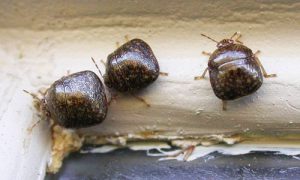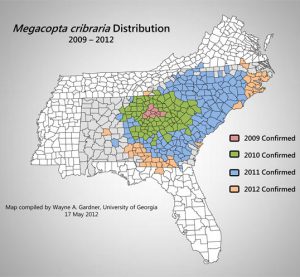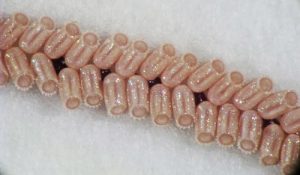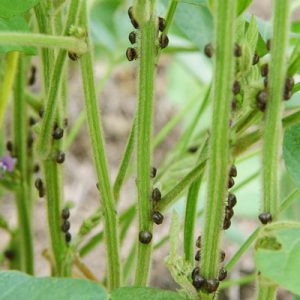The Kudzu bug, Megacopta cribraria, is also known as the bean plataspid, the lablab bug, and the globular stinkbug. This bug resembles true stinkbugs (Scutellerids), but can be distinguished by its ‘swollen’ looking body.
This is the only plataspid bug that has been established in North America. So far, the kudzu bug has been discovered in Georgia, South Carolina, North Carolina, Alabama, North Florida, and Southern Virginia. This bug tends to congregate in large numbers on and around houses in the fall and has been observed on vehicles and clothing, suggesting this bug could be easily introduced to unaffected counties.
Legumes are the primary host group of the Kudzu bug, specifically soybean, but it has been observed feeding on many other plants. This species is reported to only develop and mature on soybean and kudzu in North America. The Kudzu bug causes damage to host plants by adult and nymphal feeding on leaves, stem, flowers, and pods of that host. Large numbers of these bugs tend to congregate on host plant and may cause substantial amounts of feeding damage on the underside of leaves and stem. This damage may result in abnormal pod development and necrotic areas on plant.
This bug is not an agriculturally important pest in its native regions, but in the US it’s an important pest of soybean, lablab bean, pigeon pea, mung beans, kidney, lima and green beans. Their appetite for kudzu could potentially be a good thing, but they have the potential to greatly damage agriculturally important crops.
Watch out for this bug hitchhiking on your clothes or vehicle so as not to introduce this to unaffected locations. There aren’t many effective control methods for this bug at the moment so it’s best to stop the spread of this species.
Check out the original article here. For more information on this bug, click here.




soybeans, Glycine max (L.) Merr., in Georgia, USA. Photograph by Philip Roberts, University of Georgia, Bugwood.org.

 0
0
